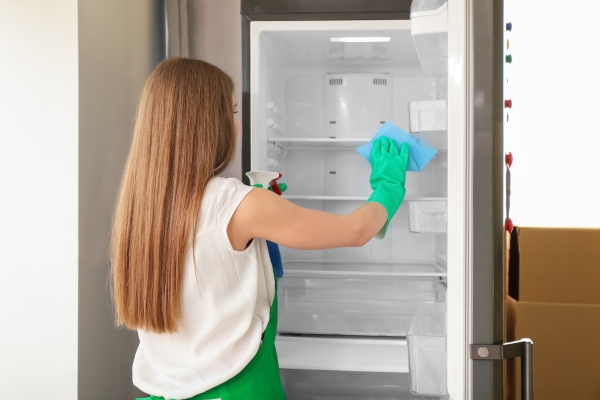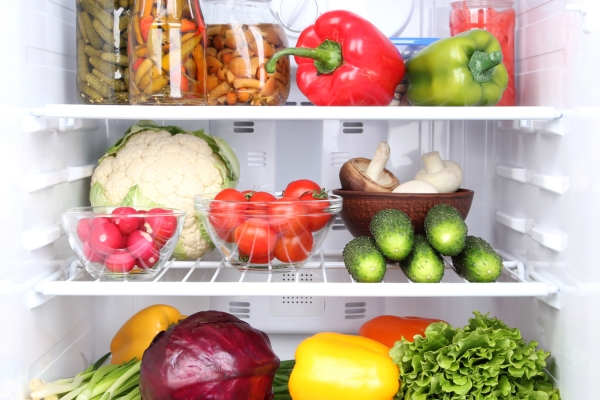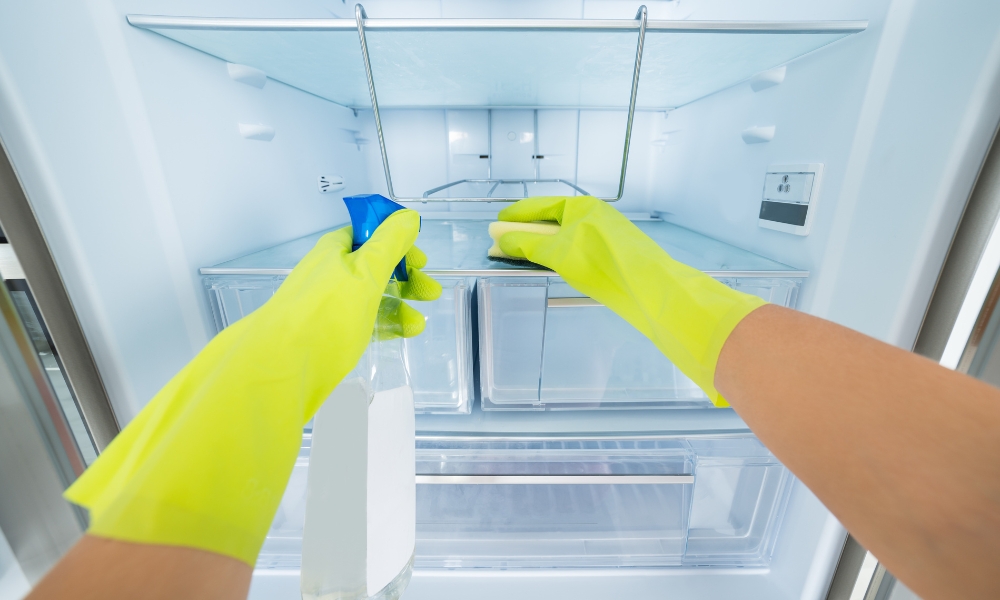Keeping your kitchen sparkling starts with maintaining clean appliances, and one of the most crucial is your refrigerator. Learning how to clean a dirty refrigerator not only enhances the hygiene and appearance of your kitchen but also extends the lifespan of your appliance and ensures the food stored inside remains safe and fresh. Regular cleaning is essential to prevent the buildup of food residues and odors, and fortunately, it’s a task you can tackle with some basic supplies and a bit of time. Embrace the peace of mind that comes with a clean, well-organized fridge, and discover how simple this task can be to promote a healthier living environment.
Preparing For The Clean
Before diving into how to clean a dirty refrigerator, it’s crucial to prepare adequately to make the process efficient and effective. Start by gathering your cleaning supplies: a gentle, food-safe detergent, baking soda for stubborn stains, microfiber cloths, a scrub brush, and a container for warm water. Additionally, have some garbage bags handy for disposing of expired items. Ensure your cleaning materials are appropriate for use in areas where food is stored to maintain safety and hygiene.
Emptying The Refrigerator

The first active step in clean your refrigerator is to empty dirty it. Remove all items from your fridge, check expiration dates, and toss anything that’s gone bad. This not only helps in reducing clutter but also gives you a chance to inventory what you have. Place the remaining food items in a cooler or another cool spot to keep them fresh during the cleaning process. This is also a great opportunity to organize your food, grouping similar items to make them easier to find later.
Initial Wipe Down

Once the refrigerator is empty, start with an initial wipe-down to remove crumbs and any liquid spills. Use a damp microfiber cloth dipped in a mixture of warm water and a small amount of dish soap. Gently wipe the interior surfaces of the fridge, including the walls and the inside of the door. This initial cleanse helps to clear away the surface dirt and makes the deeper cleaning steps more manageable.
Deep Cleaning Shelves And Drawers

For a thorough clean, remove all the shelves, drawers, and any other removable parts. Wash these components in the sink with warm soapy water, using a scrub brush to remove any stuck-on food or stains. For tougher stains, a paste made from water and baking soda can be very effective. Rinse all these parts well with clean water and dry them thoroughly to prevent frost buildup when returned to the fridge. Once everything is clean and dirty, reassemble the refrigerator, and return your food items, taking care to place them in an organized manner.
Cleaning The Interior

The key to an effective refrigerator cleaning lies in the meticulous scrubbing of its interior. After removing the contents and detachable components, use a mixture of warm water and mild dish soap or a baking soda solution to scrub the interior surfaces. For hard-to-reach areas and crevices, an old toothbrush or a dedicated scrub brush works wonders. Pay special attention to the rubber door seal, as it can harbor food particles and mold. Wipe everything down with a clean, damp cloth to remove any soap residue, ensuring that no cleaning solution is left behind.
Deodorizing The Fridge

After cleaning, tackling unpleasant odors is the next step in rejuvenating your refrigerator. A simple yet effective way to absorb and neutralize odors is by placing an open container of baking soda in the back of the fridge. For a fresh scent, consider using coffee grounds, activated charcoal, or even a few cotton balls soaked in vanilla extract. These natural deodorizers help maintain a fresh-smelling fridge and can be replaced every few months for continuous freshness.
Cleaning The Exterior

The exterior of your refrigerator also deserves attention. Wipe down the outside surfaces with a gentle cleaner suitable for your fridge’s finish (stainless steel, enamel, etc.) to avoid scratching or damage. Use a soft cloth to apply the cleaner and buff dry to prevent streaks. Don’t forget the top of the fridge and the handles, which can accumulate dust and grime. For stainless steel surfaces, a polish specifically designed for stainless steel can help restore shine and resist fingerprints.
Cleaning The Condenser Coils
For the refrigerator to operate efficiently, cleaning the condenser coils is essential. These coils can accumulate dust, pet hair, and kitchen grease, making your fridge work harder and less efficiently. Unplug the refrigerator and locate the coils; depending on the model, they can be behind the fridge or beneath it. Use a coil brush or a vacuum with a brush attachment to remove the debris from the coils. Be gentle to avoid bending or damaging the coils. Once cleaned, plug the refrigerator back in and notice the improvement in its efficiency.
Organizing The Refrigerator

Efficient organization within your refrigerator can drastically improve its functionality and accessibility. Start by assigning designated areas for different types of food; for instance, keep dairy products on the top shelves, meats in a separate drawer to avoid cross-contamination, and vegetables in the crisper where humidity levels help maintain their freshness. Utilize clear storage bins to group smaller items like snacks or condiments. And label shelves if it helps household members maintain order. An organized fridge not only helps reduce food wastage by keeping everything visible but also saves time during cooking and grocery shopping.
Maintaining Refrigerator Cleanliness
Regular maintenance is crucial to keeping your refrigerator clean and functional. Set a schedule to clean your refrigerator every month—this includes wiping down the interior surfaces, checking food expiry dates, and organizing the contents. Immediately wipe up spills to prevent odors and stains. Keep an inventory of what’s inside to avoid overbuying and overcrowding. Which can lead to poor air circulation and uneven cooling. By integrating these habits into your routine, you can maintain a consistently clean refrigerator.
Troubleshooting Common Issues
Common refrigerator issues might include unusual noises, frost buildup, or a failure to maintain the correct temperature. If your refrigerator is noisy, check to see if it is level; an unbalanced fridge can lead to strange noises during operation. Frost buildup can be a sign of a door not sealing properly check the seals and clean or replace them if they are damaged. If your refrigerator is not cooling adequately, make sure it’s not overloaded, as this can block air vents and restrict airflow. Always ensure that the condenser coils are clean, as dirty coils can affect the appliance’s efficiency. For persistent issues, consult the manual or contact a professional technician for a more thorough examination and repair.
Energy Efficiency Tips
Improving the energy efficiency of your refrigerator not only reduces your electricity bills but also minimizes your environmental footprint. Ensure that your refrigerator is not placed near heat sources such as ovens or direct sunlight, as this causes it to work harder to maintain cool temperatures. Allow hot foods to cool to room temperature before placing them in the fridge to avoid excessive energy consumption. Check the door seals regularly to ensure they are airtight. Even small leaks can force the refrigerator to run longer than necessary. Adjust the temperature settings — the fridge should be at or below 40°F (4°C), and the freezer at 0°F (-18°C). Finally, consider the age and condition of your appliance; newer models are generally more energy-efficient, and upgrading might be cost-effective in the long run.
Conclusion
Understanding how to clean and maintain your refrigerator is crucial for its optimal performance and longevity. By following these structured steps from thorough cleaning and organized storage to regular maintenance and troubleshooting you can ensure that your appliance runs efficiently and keeps your food fresh and safe. Regular upkeep not only helps in reducing energy costs but also prevents food wastage, making it a beneficial practice for both your household and the environment. Keep these tips in mind to enjoy a cleaner, more organized, and energy-efficient refrigerator.
